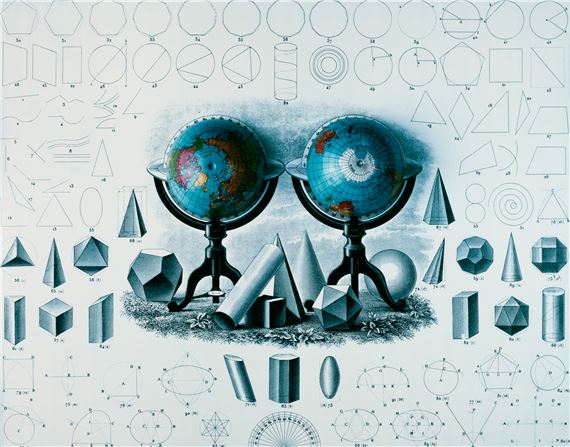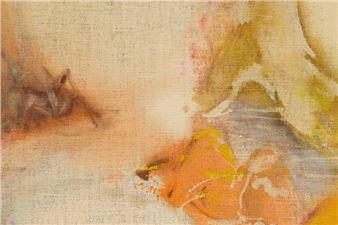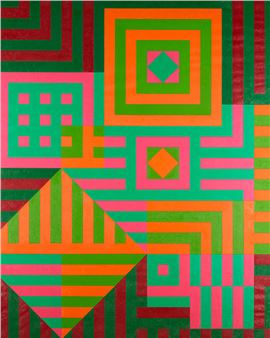Polaroid Still Lifes
In the 1980s, when staged photography became established in many fields of photographic practice, the Polaroid Company made its large-format 20√Ч24-inch camera available to numerous photographers and artists from the USA and Europe. They photographed with the man-sized camera accompanied by an operator вАУ either in the company's studios in Cambridge and Amsterdam or elsewhere at appointed sessions. A part of the resulting works became the property of the Polaroid Collection.
OstLicht, now home to around 1,300 prints of these impressively large-format, unique Polaroids, explores the still life through a selection of around fifty works by 31 artists. Inanimate objects have been arranged in the studio since the first photographic experiments in the 19th century, with the arthistorical tradition of the genre being expanded to include many aspects over the course of
photographic history.
What is staged in front of the camera in the 1980s goes far beyond what is commonly understood as a still life. In that decade of postmodernism вАУ the last phase of chemically-fixed, analogue photography before the spread of digital processes вАУ the relationship between photographic representation and reality was put to the test: its role in the tense field between fiction and documentation, mediatised construct and truthful reproduction was questioned. In contrast to the photojournalism or socio-critical documentarism of the 1970s, fictional scenarios are now constructed and photographed that are able to seduce, amaze or disturb. The boundaries between art and photography are shifting and the concept of photographic art is being coined. The protagonists come from different fields, such as sculpture, installation or media art, performative or conceptual art, advertising or fashion photography вАУ as well as from the increasing number of photography classes at universities.
The 20√Ч24-inch Polaroid camera, developed between 1976 and 1978, was an ideal tool at the time: once set up, it enabled a spontaneous arrangement of the settings вАУ sometimes the possibilities of digital image processing were anticipated in вАШanalogue montagesвАЩ and вАШsketchesвАЩ were made for the subsequent video art. In the legendary immediacy of the instant process, a unique print of magnificent colour is created, whereby the layered nature of the Polaroid emulsion forms a lacquer-like, brilliant surface that lends the scenarios a fascinating sensuality.

Recommended for you
In the 1980s, when staged photography became established in many fields of photographic practice, the Polaroid Company made its large-format 20√Ч24-inch camera available to numerous photographers and artists from the USA and Europe. They photographed with the man-sized camera accompanied by an operator вАУ either in the company's studios in Cambridge and Amsterdam or elsewhere at appointed sessions. A part of the resulting works became the property of the Polaroid Collection.
OstLicht, now home to around 1,300 prints of these impressively large-format, unique Polaroids, explores the still life through a selection of around fifty works by 31 artists. Inanimate objects have been arranged in the studio since the first photographic experiments in the 19th century, with the arthistorical tradition of the genre being expanded to include many aspects over the course of
photographic history.
What is staged in front of the camera in the 1980s goes far beyond what is commonly understood as a still life. In that decade of postmodernism вАУ the last phase of chemically-fixed, analogue photography before the spread of digital processes вАУ the relationship between photographic representation and reality was put to the test: its role in the tense field between fiction and documentation, mediatised construct and truthful reproduction was questioned. In contrast to the photojournalism or socio-critical documentarism of the 1970s, fictional scenarios are now constructed and photographed that are able to seduce, amaze or disturb. The boundaries between art and photography are shifting and the concept of photographic art is being coined. The protagonists come from different fields, such as sculpture, installation or media art, performative or conceptual art, advertising or fashion photography вАУ as well as from the increasing number of photography classes at universities.
The 20√Ч24-inch Polaroid camera, developed between 1976 and 1978, was an ideal tool at the time: once set up, it enabled a spontaneous arrangement of the settings вАУ sometimes the possibilities of digital image processing were anticipated in вАШanalogue montagesвАЩ and вАШsketchesвАЩ were made for the subsequent video art. In the legendary immediacy of the instant process, a unique print of magnificent colour is created, whereby the layered nature of the Polaroid emulsion forms a lacquer-like, brilliant surface that lends the scenarios a fascinating sensuality.
Artists on show
- Barbara Kasten
- Barbara Norfleet
- Bettina Rheims
- Boyd Webb
- Charles Purvis
- David Levinthal
- Evergon
- Frank Gillette
- György Kepes
- Helen Chadwick
- Iain Baxter
- J.C. Dewolf
- John Craig
- John Gintoff
- Klaus Frahm
- Linda Lindroth
- Luigi Ghirri
- Melanie Walker
- Michael Hudock
- Olivia Parker
- Rainer Griese
- Rena Small
- Rena Small
- Sally Mann
- Sandi Fellman
- Ulrich Mack
- Verena von Gagern
- Vicki Lee Ragan
- Werner Schnelle
- Wilko van Oostrum
- William Wegman
- Zarina Bhimji

 ARTISTS
ARTISTS
















